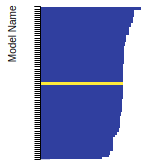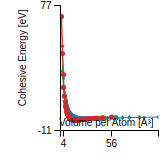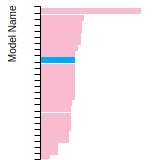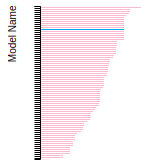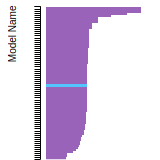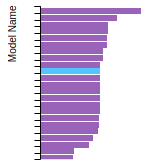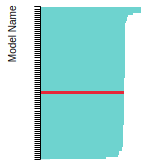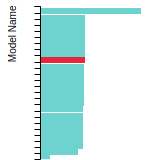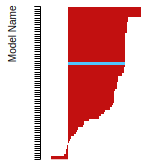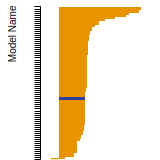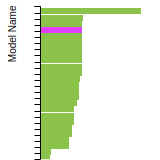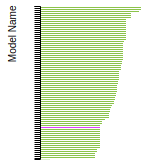 MEAM_LAMMPS_KimKimLee_2009_AlMg__MO_058537087384_002
MEAM_LAMMPS_KimKimLee_2009_AlMg__MO_058537087384_002
| Title
A single sentence description.
|
MEAM Potential for the Al-Mg system developed by Kim, Kim, and Lee (2009) v002 |
|---|---|
| Description
A short description of the Model describing its key features including for example: type of model (pair potential, 3-body potential, EAM, etc.), modeled species (Ac, Ag, ..., Zr), intended purpose, origin, and so on.
|
Interatomic potential for the Mg–Al binary system has been developed based on the modified embedded-atom method (MEAM) potential formalism. The potential can describe alloy behaviors (thermodynamic, structural and elastic properties) in reasonable agreement with experimental data or higher-level calculations. |
| Species
The supported atomic species.
| Al, Mg |
| Disclaimer
A statement of applicability provided by the contributor, informing users of the intended use of this KIM Item.
|
None |
| Content Origin | http://cmse.postech.ac.kr/home_2nnmeam |
| Contributor |
Jong-Kwan Lee |
| Maintainer |
Jong-Kwan Lee |
| Developer |
Young-Min Kim Nack J. Kim Byeong-Joo Lee |
| Published on KIM | 2023 |
| How to Cite |
This Model originally published in [1] is archived in OpenKIM [2-5]. [1] Kim Y-M, Kim NJ, Lee B-J. Atomistic modeling of pure Mg and Mg–Al systems. Calphad. 2009;33(4):650–7. doi:10.1016/j.calphad.2009.07.004 — (Primary Source) A primary source is a reference directly related to the item documenting its development, as opposed to other sources that are provided as background information. [2] Kim Y-M, Kim NJ, Lee B-J. MEAM Potential for the Al-Mg system developed by Kim, Kim, and Lee (2009) v002. OpenKIM; 2023. doi:10.25950/525e9efc [3] Afshar Y, Hütter S, Rudd RE, Stukowski A, Tipton WW, Trinkle DR, et al. The modified embedded atom method (MEAM) potential v002. OpenKIM; 2023. doi:10.25950/ee5eba52 [4] Tadmor EB, Elliott RS, Sethna JP, Miller RE, Becker CA. The potential of atomistic simulations and the Knowledgebase of Interatomic Models. JOM. 2011;63(7):17. doi:10.1007/s11837-011-0102-6 [5] Elliott RS, Tadmor EB. Knowledgebase of Interatomic Models (KIM) Application Programming Interface (API). OpenKIM; 2011. doi:10.25950/ff8f563a Click here to download the above citation in BibTeX format. |
| Citations
This panel presents information regarding the papers that have cited the interatomic potential (IP) whose page you are on. The OpenKIM machine learning based Deep Citation framework is used to determine whether the citing article actually used the IP in computations (denoted by "USED") or only provides it as a background citation (denoted by "NOT USED"). For more details on Deep Citation and how to work with this panel, click the documentation link at the top of the panel. The word cloud to the right is generated from the abstracts of IP principle source(s) (given below in "How to Cite") and the citing articles that were determined to have used the IP in order to provide users with a quick sense of the types of physical phenomena to which this IP is applied. The bar chart shows the number of articles that cited the IP per year. Each bar is divided into green (articles that USED the IP) and blue (articles that did NOT USE the IP). Users are encouraged to correct Deep Citation errors in determination by clicking the speech icon next to a citing article and providing updated information. This will be integrated into the next Deep Citation learning cycle, which occurs on a regular basis. OpenKIM acknowledges the support of the Allen Institute for AI through the Semantic Scholar project for providing citation information and full text of articles when available, which are used to train the Deep Citation ML algorithm. |
This panel provides information on past usage of this interatomic potential (IP) powered by the OpenKIM Deep Citation framework. The word cloud indicates typical applications of the potential. The bar chart shows citations per year of this IP (bars are divided into articles that used the IP (green) and those that did not (blue)). The complete list of articles that cited this IP is provided below along with the Deep Citation determination on usage. See the Deep Citation documentation for more information. 
111 Citations (85 used)
Help us to determine which of the papers that cite this potential actually used it to perform calculations. If you know, click the .
USED (high confidence) Y. Hu and D. Kochmann, “Atomistic insight into three-dimensional twin embryo growth in Mg alloys,” Journal of Materials Science. 2023. link Times cited: 1 USED (high confidence) P. Yi, T. Sasaki, S. Prameela, T. Weihs, and M. Falk, “The Interplay between Solute Atoms and Vacancy Clusters in Magnesium Alloys,” SSRN Electronic Journal. 2021. link Times cited: 2 Abstract: Atomic-scale calculations indicate that both stress effects … read more USED (high confidence) J.-K. Lee and B.-J. Lee, “The Origin of Activation of Non-basal Slip in Mg-Ce Dilute Alloy: An Atomistic Simulation Study,” Metallurgical and Materials Transactions A. 2021. link Times cited: 9 USED (high confidence) J. Gu’enol’e et al., “Assessment and optimization of the fast inertial relaxation engine (fire) for energy minimization in atomistic simulations and its implementation in lammps,” Computational Materials Science. 2019. link Times cited: 89 USED (high confidence) A. Vaid, J. Gu’enol’e, A. Prakash, S. Korte-Kerzel, and E. Bitzek, “Atomistic simulations of basal dislocations in Mg interacting with Mg17Al12 precipitates,” Materialia. 2019. link Times cited: 29 USED (high confidence) D. Dickel, M. Baskes, I. Aslam, and C. Barrett, “New interatomic potential for Mg–Al–Zn alloys with specific application to dilute Mg-based alloys,” Modelling and Simulation in Materials Science and Engineering. 2018. link Times cited: 42 Abstract: Because of its very large c/a ratio, zinc has proven to be a… read more USED (high confidence) Peng 鹏 Yi 易, R. Cammarata, and M. Falk, “Solute softening and defect generation during prismatic slip in magnesium alloys,” Modelling and Simulation in Materials Science and Engineering. 2017. link Times cited: 16 Abstract: Temperature and solute effects on prismatic slip of 〈a〉 disl… read more USED (high confidence) D. Sun, M. Ponga, K. Bhattacharya, and M. Ortiz, “Proliferation of twinning in hexagonal close-packed metals: Application to magnesium,” Journal of The Mechanics and Physics of Solids. 2017. link Times cited: 26 USED (high confidence) G. Zu and S. Groh, “Effect of segregated alloying element on the intrinsic fracture behavior of Mg,” Theoretical and Applied Fracture Mechanics. 2016. link Times cited: 3 USED (high confidence) E. Asadi and M. A. Zaeem, “The anisotropy of hexagonal close-packed and liquid interface free energy using molecular dynamics simulations based on modified embedded-atom method,” Acta Materialia. 2016. link Times cited: 37 USED (high confidence) G. Nandipati, N. Govind, A. Andersen, and A. Rohatgi, “Self-learning kinetic Monte Carlo simulations of Al diffusion in Mg,” Journal of Physics: Condensed Matter. 2016. link Times cited: 17 Abstract: Vacancy-mediated diffusion of an Al atom in the pure Mg matr… read more USED (high confidence) Z. Wu and W. Curtin, “Brittle and ductile crack-tip behavior in magnesium,” Acta Materialia. 2015. link Times cited: 77 USED (high confidence) H.-S. Jang and B. Lee, “A Modified Embedded-Atom Method Interatomic Potential for the Mg–Mn Binary System,” MATERIALS TRANSACTIONS. 2022. link Times cited: 0 USED (low confidence) Z. Sun et al., “Study on the effect of the ECAP deformation on the organization and properties of the extruded Mg-Sn-Al alloys,” Materials Letters. 2023. link Times cited: 0 USED (low confidence) J. S. Lee et al., “Atomistic investigation into the formation of axial weak twins during the compression of single-crystal Mg nanopillars,” Acta Materialia. 2023. link Times cited: 0 USED (low confidence) C. Wang, “Age-hardening behavior of the extruded Al 7075/Mg EW75 composite,” Materials Today Communications. 2023. link Times cited: 0 USED (low confidence) A. Moitra, “Twin-boundary and precipitate interaction in Mg–Al alloy: an MD study,” Modelling and Simulation in Materials Science and Engineering. 2023. link Times cited: 0 Abstract: Strengthening of Mg-alloys by precipitation is much less eff… read more USED (low confidence) E. Ibrahim, Y. Lysogorskiy, M. Mrovec, and R. Drautz, “Atomic cluster expansion for a general-purpose interatomic potential of magnesium,” Physical Review Materials. 2023. link Times cited: 2 Abstract: We present a general-purpose parameterization of the atomic … read more USED (low confidence) D. Dolce, A. Swamy, J. Hoyt, and P. Choudhury, “Computing the solid-liquid interfacial free energy and anisotropy of the Al-Mg system using a MEAM potential with atomistic simulations,” Computational Materials Science. 2023. link Times cited: 5 USED (low confidence) G. Shen et al., “Effect of nano-CaO particle on the microstructure, mechanical properties and corrosion behavior of lean Mg-1Zn alloy,” Journal of Magnesium and Alloys. 2023. link Times cited: 4 USED (low confidence) B. Waters, D. S. Karls, I. Nikiforov, R. Elliott, E. Tadmor, and B. Runnels, “Automated determination of grain boundary energy and potential-dependence using the OpenKIM framework,” Computational Materials Science. 2022. link Times cited: 5 USED (low confidence) A. Altoyuri, J. Syarif, and Z. Sajuri, “Deformation behavior of single-crystal magnesium during Nano-ECAP simulation,” Heliyon. 2022. link Times cited: 1 USED (low confidence) H. Cai, Z. Wang, L. Liu, Y. Li, and F. Guo, “Regulation mechanism of cooling rate and RE (Ce, Y, Gd) on Mg17Al12 in AZ91 alloy and it’s role in fracture process,” Journal of Materials Research and Technology. 2022. link Times cited: 2 USED (low confidence) H. Xue, T. Cui, H. Guo, R. Chu, C.-xiang Zhang, and J. Luo, “A molecular dynamics study on the cyclic plastic deformation mechanism of Al–Mg alloys,” Journal of Applied Physics. 2022. link Times cited: 1 USED (low confidence) T. Wang and F. Liu, “Optimizing mechanical properties of magnesium alloys by philosophy of thermo-kinetic synergy: Review and outlook,” Journal of Magnesium and Alloys. 2022. link Times cited: 24 USED (low confidence) A. Mahata, T. Mukhopadhyay, and M. A. Zaeem, “Modified embedded-atom method interatomic potentials for Al-Cu, Al-Fe and Al-Ni binary alloys: From room temperature to melting point,” Computational Materials Science. 2022. link Times cited: 27 USED (low confidence) Z. Jian et al., “Shock-induced plasticity and phase transformation in single crystal magnesium: an interatomic potential and non-equilibrium molecular dynamics simulations,” Journal of Physics: Condensed Matter. 2021. link Times cited: 8 Abstract: An effective and reliable Finnis–Sinclair (FS) type potentia… read more USED (low confidence) M. S. Nitol, S. Mun, D. Dickel, and C. Barrett, “Unraveling Mg 〈c + a〉 slip using neural network potential,” Philosophical Magazine. 2021. link Times cited: 8 Abstract: ABSTRACT Magnesium (Mg) activates 〈c + a〉 dislocation slip o… read more USED (low confidence) S. Chen, Z. Aitken, V. Sorkin, Z. Yu, Z. Wu, and Y.-W. Zhang, “Modified Embedded‐Atom Method Potentials for the Plasticity and Fracture Behaviors of Unary HCP Metals,” Advanced Theory and Simulations. 2021. link Times cited: 3 Abstract: Modified embedded‐atom method (MEAM) potentials have been wi… read more USED (low confidence) S. Wang and Q. Zu, “Lithium/yttrium cluster effect on 101-1 twin boundary migration in magnesium,” Results in physics. 2021. link Times cited: 0 USED (low confidence) J.-J. Tang, W. Jiang, Q. Wang, X. Tian, D. Wei, and H. Fan, “Hardening effects of sheared precipitates on 112¯1 twinning in magnesium alloys,” Journal of Magnesium and Alloys. 2021. link Times cited: 2 USED (low confidence) H.-S. Jang, J.-K. Lee, A. J. Tapia, N. Kim, and B.-J. Lee, “Activation of non-basal slip in multicomponent Mg alloys,” Journal of Magnesium and Alloys. 2021. link Times cited: 23 USED (low confidence) P. Yi, “Solute Softening and Vacancy Generation by Diffusion-Less Dislocation Climb in Magnesium Alloys,” Chemical Engineering (Engineering) eJournal. 2021. link Times cited: 5 Abstract: Active room temperature solute induced diffusion-less climb … read more USED (low confidence) M. S. Nitol, D. Dickel, and C. Barrett, “Artificial neural network potential for pure zinc,” Computational Materials Science. 2021. link Times cited: 11 USED (low confidence) K. Hsieh, Y.-Y. Lin, C.-H. Lu, J. Yang, P. Liaw, and C.-L. Kuo, “Atomistic simulations of the face-centered-cubic-to-hexagonal-close-packed phase transformation in the equiatomic CoCrFeMnNi high entropy alloy under high compression,” Computational Materials Science. 2020. link Times cited: 21 Abstract: We performed the modified-embedded-atom-method (MEAM) based … read more USED (low confidence) H.-S. Jang, D. Seol, and B.-J. Lee, “Modified embedded-atom method interatomic potentials for Mg–Al–Ca and Mg–Al–Zn ternary systems,” Journal of Magnesium and Alloys. 2020. link Times cited: 28 USED (low confidence) Y. Wu, T. Zhou, R. Yu, Q. Lai, H. Wang, and J. You, “A New Crystallization Pattern of Nested Tetrahedral Lamellar Structure for the Face-Centered Cubic Metals with Low Stacking Fault Energy,” MatSciRN: Other Materials Performance (Topic). 2020. link Times cited: 7 Abstract: It's well known that the lamellar (LAM) and five-fold-t… read more USED (low confidence) D. Spearot, V. Taupin, K. Dang, and L. Capolungo, “Structure and kinetics of three-dimensional defects on the 101¯2 twin boundary in magnesium: Atomistic and phase-field simulations,” Mechanics of Materials. 2020. link Times cited: 14 USED (low confidence) R. Boom and F. D. Boer, “Enthalpy of formation of binary solid and liquid Mg alloys – Comparison of Miedema-model calculations with data reported in literature,” Calphad-computer Coupling of Phase Diagrams and Thermochemistry. 2020. link Times cited: 4 USED (low confidence) D. Kumar, S. Goel, N. Gosvami, and J. Jain, “Towards an improved understanding of plasticity, friction and wear mechanisms in precipitate containing AZ91 Mg alloy,” Materialia. 2020. link Times cited: 8 USED (low confidence) H.-S. Jang, D. Seol, and B.-J. Lee, “Modified embedded-atom method interatomic potential for the Mg–Zn–Ca ternary system,” Calphad-computer Coupling of Phase Diagrams and Thermochemistry. 2019. link Times cited: 6 USED (low confidence) I. Aslam et al., “Thermodynamic and kinetic behavior of low-alloy steels: An atomic level study using an Fe-Mn-Si-C modified embedded atom method (MEAM) potential,” Materialia. 2019. link Times cited: 12 USED (low confidence) G. Esteban-Manzanares, A. Ma, I. Papadimitriou, E. Martínez, and J. Llorca, “Basal dislocation/precipitate interactions in Mg–Al alloys: an atomistic investigation,” Modelling and Simulation in Materials Science and Engineering. 2019. link Times cited: 19 Abstract: The interaction between edge basal dislocations and β-Mg17Al… read more USED (low confidence) D. Spearot, L. Capolungo, and C. Tomé, “Shear-driven motion of Mg
101¯2
twin boundaries via disconnection terrace nucleation, growth, and coalescence,” Physical Review Materials. 2019. link Times cited: 15 USED (low confidence) P. Yi and M. Falk, “Thermally activated twin thickening and solute softening in magnesium alloys - a molecular simulation study,” Scripta Materialia. 2019. link Times cited: 11 USED (low confidence) H.-S. Jang and B.-J. Lee, “Effects of Zn on 〈c + a〉 slip and grain boundary segregation of Mg alloys,” Scripta Materialia. 2019. link Times cited: 44 USED (low confidence) S. A. Etesami, M. Laradji, and E. Asadi, “Transferability of interatomic potentials in predicting the temperature dependency of elastic constants for titanium, zirconium and magnesium,” Modelling and Simulation in Materials Science and Engineering. 2019. link Times cited: 4 Abstract: We present our investigation of the current state of the art… read more USED (low confidence) K. Srivastava, S. Rao, and J. El-Awady, “Unveiling the role of super-jogs and dislocation induced atomic-shuffling on controlling plasticity in magnesium,” Acta Materialia. 2018. link Times cited: 18 USED (low confidence) J. Zhang, Y. Zhang, J. El-Awady, and Y. Tang, “The plausibility of dislocation slip on -12-11 planes in Mg,” Scripta Materialia. 2018. link Times cited: 6 USED (low confidence) H.-S. Jang, K.-M. Kim, and B.-J. Lee, “Modified embedded-atom method interatomic potentials for pure Zn and Mg-Zn binary system,” Calphad-computer Coupling of Phase Diagrams and Thermochemistry. 2018. link Times cited: 23 USED (low confidence) C. Barrett, A. Imandoust, and H. Kadiri, “The effect of rare earth element segregation on grain boundary energy and mobility in magnesium and ensuing texture weakening,” Scripta Materialia. 2018. link Times cited: 94 USED (low confidence) K. Kim, J.-H. Hwang, H.-S. Jang, J. Jeon, N. Kim, and B.-J. Lee, “Dislocation binding as an origin for the improvement of room temperature ductility in Mg alloys,” Materials Science and Engineering A-structural Materials Properties Microstructure and Processing. 2018. link Times cited: 54 USED (low confidence) R. Kobayashi, D. Giofré, T. Junge, M. Ceriotti, and W. Curtin, “Neural network potential for Al-Mg-Si alloys,” Physical Review Materials. 2017. link Times cited: 59 Abstract: The 6000 series Al alloys, which include a few percent of Mg… read more USED (low confidence) X.-song Huang et al., “Investigation of atom distribution in Mg-9wt.%Al melt using small-angle X-ray scattering and molecular dynamics simulation,” Journal of Non-crystalline Solids. 2017. link Times cited: 6 USED (low confidence) C. Grégoire and M. Ponga, “Nanovoid failure in Magnesium under dynamic loads,” Acta Materialia. 2017. link Times cited: 11 USED (low confidence) J. Luo, Y. Jiang, R. Yu, and Y. Wu, “The competition of densification and structure ordering during crystallization of HCP-Mg in the framework of layering,” Chemical Physics Letters. 2017. link Times cited: 3 USED (low confidence) K. Kim and B.-J. Lee, “Modified embedded-atom method interatomic potentials for Mg-Nd and Mg-Pb binary systems,” Calphad-computer Coupling of Phase Diagrams and Thermochemistry. 2017. link Times cited: 12 USED (low confidence) H. Ning et al., “Hydrogen dissociation and incorporation on Mg 17 Al 12 (100) surface: A density functional theory study,” Applied Surface Science. 2017. link Times cited: 14 USED (low confidence) M. Zacate, “Indium-defect interactions in FCC and BCC metals studied using the modified embedded atom method,” Hyperfine Interactions. 2016. link Times cited: 0 USED (low confidence) S. Rawat and S. Joshi, “Effect of multiaxial loading on evolution of 101¯2 twinning in magnesium single crystals,” Materials Science and Engineering A-structural Materials Properties Microstructure and Processing. 2016. link Times cited: 20 USED (low confidence) P. Yi, R. Cammarata, and M. Falk, “Atomistic simulation of solid solution hardening in Mg/Al alloys: Examination of composition scaling and thermo-mechanical relationships,” Acta Materialia. 2016. link Times cited: 20 USED (low confidence) E. Asadi and M. A. Zaeem, “Predicting Solidification Properties of Magnesium by Molecular Dynamics Simulations.” 2016. link Times cited: 0 USED (low confidence) A. P. Moore, B. Beeler, C. Deo, M. Baskes, and M. Okuniewski, “Atomistic modeling of high temperature uranium–zirconium alloy structure and thermodynamics,” Journal of Nuclear Materials. 2015. link Times cited: 41 USED (low confidence) K. Kim, J. Jeon, N. Kim, and B.-J. Lee, “Role of yttrium in activation of 〈c + a〉 slip in magnesium: An atomistic approach,” Scripta Materialia. 2015. link Times cited: 101 USED (low confidence) E. Cyr, M. Mohammadi, R. Mishra, and K. Inal, “A three dimensional (3D) thermo-elasto-viscoplastic constitutive model for FCC polycrystals,” International Journal of Plasticity. 2015. link Times cited: 38 USED (low confidence) K. Kim, J. Jeon, and B.-J. Lee, “Modified embedded-atom method interatomic potentials for Mg–X (X=Y, Sn, Ca) binary systems,” Calphad-computer Coupling of Phase Diagrams and Thermochemistry. 2015. link Times cited: 70 USED (low confidence) J. Xiao, R.-B. Li, and Y. Wu, “Ostwald’s Step Rule in the Crystallization of Supercooled Magnesium from Molecular Dynamic Simulation.” 2015. link Times cited: 0 USED (low confidence) S. Groh, “Mechanical, thermal, and physical properties of Mg-Ca compounds in the framework of the modified embedded-atom method.,” Journal of the mechanical behavior of biomedical materials. 2015. link Times cited: 16 USED (low confidence) S. Groh, “Transformation of shear loop into prismatic loops during bypass of an array of impenetrable particles by edge dislocations,” Materials Science and Engineering A-structural Materials Properties Microstructure and Processing. 2014. link Times cited: 15 USED (low confidence) M. Ghazisaeidi, L. Hector, and W. Curtin, “First-principles core structures of edge and screw dislocations in Mg,” Scripta Materialia. 2014. link Times cited: 76 USED (low confidence) W. Xiao, X. Zhang, W. Geng, and G. Lu, “Atomistic study of plastic deformation in Mg–Al alloys,” Materials Science and Engineering A-structural Materials Properties Microstructure and Processing. 2013. link Times cited: 30 USED (low confidence) B. Jelinek et al., “Modified embedded atom method potential for Al, Si, Mg, Cu, and Fe alloys,” Physical Review B. 2011. link Times cited: 218 Abstract: A set of modified embedded-atom method (MEAM) potentials for… read more USED (low confidence) J. Han, X. Su, Z. Jin, and Y. Zhu, “Basal‐Plane Stacking‐Fault Energies of Mg: A First‐Principles Study of Li‐ and Al‐Alloying Effects,” Scripta Materialia. 2011. link Times cited: 125 USED (low confidence) J. Fan, “Applications of Atomistic Simulation in Ceramics and Metals.” 2010. link Times cited: 0 USED (low confidence) B.-J. Lee, W. Ko, H.-K. Kim, and E.-H. Kim, “The modified embedded-atom method interatomic potentials and recent progress in atomistic simulations,” Calphad-computer Coupling of Phase Diagrams and Thermochemistry. 2010. link Times cited: 137 USED (low confidence) A. Mahata, T. Mukhopadhyay, and M. A. Zaeem, “Liquid ordering induced heterogeneities in homogeneous nucleation during solidification of pure metals,” Journal of Materials Science & Technology. 2022. link Times cited: 11 USED (low confidence) S. E. Prameela, T. Sasaki, P. Yi, M. Falk, K. Hono, and T. Weihs, “Unlocking the Strengthening Potential of Magnesium Alloys Using Deformation-Induced Clustering and Precipitation,” The Minerals, Metals & Materials Series. 2022. link Times cited: 1 USED (low confidence) C. Barrett, M. S. Nitol, and D. Dickel, “Unraveling Mg Slip Using Neural Network Potentials,” The Minerals, Metals & Materials Series. 2022. link Times cited: 0 USED (low confidence) J. F. Troncoso and V. Turlo, “Evaluating the applicability of classical and neural network interatomic potentials for modeling body centered cubic polymorph of magnesium,” Modelling and Simulation in Materials Science and Engineering. 2022. link Times cited: 2 Abstract: Magnesium (Mg) is one of the most abundant metallic elements… read more USED (low confidence) K. Dang, J. Graham, C. Tomé, and L. Capolungo, “Three-Dimensional Interaction of $ \left{ 10\bar12 \right} $ Twin with Tilt Boundaries in Mg: Twin and Dislocation Transmission.” 2021. link Times cited: 1 USED (low confidence) K. Dang, C. Tomé, and L. Capolungo, “Three-Dimensional Atomistic Simulations of $ \left{ 10\bar12 \right}$ Non-cozone Twin–Twin Interaction in Mg—Role of Twin Stability and Mobility.” 2021. link Times cited: 0 USED (low confidence) K. Srivastava and J. El-Awady, “The Effect of the Orientation of Second-Order Pyramidal Dislocations on Plastic Flow in Magnesium,” The Minerals, Metals & Materials Series. 2019. link Times cited: 1 USED (low confidence) S. Groh and M. K. Nahhas, “Modeling Dislocation in Binary Magnesium-Based Alloys Using Atomistic Method,” Handbook of Mechanics of Materials. 2019. link Times cited: 1 USED (low confidence) C. Grégoire, “Dynamic behaviour of nano-sized voids in hexagonal close-packed materials.” 2018. link Times cited: 0 Abstract: The dynamic behaviour and failure mechanisms of nano-sized v… read more USED (low confidence) S. Agnew, L. Capolungo, and C. Calhoun, “Connections between the basal I1 ‘growth’ fault and 〈c+a〉 dislocations,” Acta Materialia. 2015. link Times cited: 81 NOT USED (low confidence) H.-S. Jang, K. Kim, N. Kim, and B.-J. Lee, “Understanding on the Role of Rare Earth Elements in Activation of $ \left⟨\textc + \texta \right⟩$ Slip in Magnesium: An Atomistic Approach.” 2017. link Times cited: 0 NOT USED (high confidence) M. Poul, L. Huber, E. Bitzek, and J. Neugebauer, “Systematic atomic structure datasets for machine learning potentials: Application to defects in magnesium,” Physical Review B. 2022. link Times cited: 3 Abstract: We present a physically motivated strategy for the construct… read more NOT USED (high confidence) A. Ostapovets and O. Vatazhuk, “Комп’ютерне моделювання впливу гідростатичного тиску на ковзання гвинтових дислокацій в Mg.” 2020. link Times cited: 0 Abstract: Atomistic modeling of hydrostatic pressure influence on crit… read more NOT USED (high confidence) R. Fogarty, J. Smutná, M. Wenman, and A. Horsfield, “Beyond two-center tight binding: Models for Mg and Zr,” Physical Review Materials. 2020. link Times cited: 0 NOT USED (high confidence) M. Stricker, B. Yin, E. Mak, and W. Curtin, “Machine learning for metallurgy II. A neural-network potential for magnesium,” Physical Review Materials. 2020. link Times cited: 26 Abstract: Interatomic potentials are essential for studying fundamenta… read more NOT USED (high confidence) M. Alidoust, D. Kleiven, and J. Akola, “Density functional simulations of pressurized Mg-Zn and Al-Zn alloys,” Physical Review Materials. 2020. link Times cited: 5 Abstract: The Mg-Zn and Al-Zn binary alloys have been investigated the… read more NOT USED (high confidence) J.-yu Yang, Y. Zhang, Y. Liu, W. Hu, and X. Dai, “A comparative atomic simulation study of the configurations in M-Al (M = Mg, Ni, and Fe) nanoalloys: influence of alloying ability, surface energy, atomic radius, and atomic arrangement,” Journal of Nanoparticle Research. 2020. link Times cited: 3 NOT USED (high confidence) S.-J. Sun, S. Ju, C.-C. Yang, K.-C. Chang, and I.-J. Lee, “Effects of Strontium incorporation to Mg-Zn-Ca biodegradable bulk metallic glass investigated by molecular dynamics simulation and density functional theory calculation,” Scientific Reports. 2020. link Times cited: 6 NOT USED (high confidence) A. Mahata and M. A. Zaeem, “Size effect in molecular dynamics simulation of nucleation process during solidification of pure metals: investigating modified embedded atom method interatomic potentials,” Modelling and Simulation in Materials Science and Engineering. 2019. link Times cited: 8 Abstract: Due to the significant increase in computing power in recent… read more NOT USED (high confidence) M. Zacate, “Modified embedded-atom method potential for cadmium,” Hyperfine Interactions. 2019. link Times cited: 0 NOT USED (high confidence) L. N. Abdulkadir, K. Abou-El-Hossein, A. I. Jumare, M. Liman, T. A. Olaniyan, and P. B. Odedeyi, “Review of molecular dynamics/experimental study of diamond-silicon behavior in nanoscale machining,” The International Journal of Advanced Manufacturing Technology. 2018. link Times cited: 38 NOT USED (high confidence) L. N. Abdulkadir, K. Abou-El-Hossein, A. I. Jumare, M. Liman, T. A. Olaniyan, and P. B. Odedeyi, “Review of molecular dynamics/experimental study of diamond-silicon behavior in nanoscale machining,” The International Journal of Advanced Manufacturing Technology. 2018. link Times cited: 0 NOT USED (high confidence) M. K. Nahhas and S. Groh, “Atomistic modeling of grain boundary behavior under shear conditions in magnesium and magnesium-based binary alloys,” Journal of Physics and Chemistry of Solids. 2018. link Times cited: 12 NOT USED (high confidence) Y. Tang, “Uncovering the inertia of dislocation motion and negative mechanical response in crystals,” Scientific Reports. 2018. link Times cited: 19 NOT USED (high confidence) M. Zacate, “Indium-defect interactions in FCC and BCC metals studied using the modified embedded atom method,” Hyperfine Interactions. 2016. link Times cited: 1 NOT USED (high confidence) S. Groh, “Modified embedded-atom potential for B2-MgAg,” Modelling and Simulation in Materials Science and Engineering. 2016. link Times cited: 5 Abstract: Interatomic potentials for pure Ag and Mg–Ag alloy have been… read more NOT USED (high confidence) Z. Wu, M. Francis, and W. Curtin, “Magnesium interatomic potential for simulating plasticity and fracture phenomena,” Modelling and Simulation in Materials Science and Engineering. 2015. link Times cited: 128 Abstract: Magnesium has multiple dislocation and twinning systems with… read more NOT USED (high confidence) W. Ko and B.-J. Lee, “Modified embedded-atom method interatomic potentials for pure Y and the V–Pd–Y ternary system,” Modelling and Simulation in Materials Science and Engineering. 2013. link Times cited: 20 Abstract: Interatomic potentials for pure Y and the V–Pd–Y ternary sys… read more NOT USED (high confidence) J. Chun and B. Lee, “Atomistic calculations of mechanical properties of Ni-Ti-C metallic glass systems,” Journal of Mechanical Science and Technology. 2013. link Times cited: 3 NOT USED (high confidence) J. Chun and B. Lee, “Atomistic calculations of mechanical properties of Ni-Ti-C metallic glass systems,” Journal of Mechanical Science and Technology. 2013. link Times cited: 0 NOT USED (high confidence) H. Zhang and S. Wang, “A first-principles study on hot crack mechanism in Mg-Al-Ca alloys,” Journal of Materials Research. 2012. link Times cited: 7 Abstract: The use of Mg-Al-Ca alloys is limited mainly due to the hot … read more NOT USED (high confidence) Z. Cui, F. Gao, Z. Cui, and J. Qu, “A second nearest-neighbor embedded atom method interatomic potential for Li-Si alloys,” Journal of Power Sources. 2012. link Times cited: 172 NOT USED (high confidence) “Computer simulations of hydrostatic pressure influence on screw dislocation slip in Mg,” The Journal of V. N. Karazin Kharkiv National University, Series "Physics". 2020. link Times cited: 0 Abstract: Atomistic modeling of hydrostatic pressure influence on crit… read more NOT USED (high confidence) D. Sun, “Proliferation of Twinning in Metals: Application to Magnesium Alloys.” 2018. link Times cited: 2 Abstract: In the search for new alloys with a great strength-to-weight… read more NOT USED (high confidence) A. P. Moore, C. Deo, M. Baskes, M. Okuniewski, and D. McDowell, “Understanding the uncertainty of interatomic potentials’ parameters and formalism,” Computational Materials Science. 2017. link Times cited: 17 NOT USED (high confidence) Z. Cui, F. Gao, Z. Cui, and J. Qu, “Developing a second nearest-neighbor modified embedded atom method interatomic potential for lithium,” Modelling and Simulation in Materials Science and Engineering. 2011. link Times cited: 66 Abstract: This paper reports the development of a second nearest-neigh… read more |
| Funding | Not available |
| Short KIM ID
The unique KIM identifier code.
| MO_058537087384_002 |
| Extended KIM ID
The long form of the KIM ID including a human readable prefix (100 characters max), two underscores, and the Short KIM ID. Extended KIM IDs can only contain alpha-numeric characters (letters and digits) and underscores and must begin with a letter.
| MEAM_LAMMPS_KimKimLee_2009_AlMg__MO_058537087384_002 |
| DOI |
10.25950/525e9efc https://doi.org/10.25950/525e9efc https://commons.datacite.org/doi.org/10.25950/525e9efc |
| KIM Item Type
Specifies whether this is a Portable Model (software implementation of an interatomic model); Portable Model with parameter file (parameter file to be read in by a Model Driver); Model Driver (software implementation of an interatomic model that reads in parameters).
| Portable Model using Model Driver MEAM_LAMMPS__MD_249792265679_002 |
| Driver | MEAM_LAMMPS__MD_249792265679_002 |
| KIM API Version | 2.2 |
| Potential Type | meam |
| Previous Version | MEAM_LAMMPS_KimKimLee_2009_AlMg__MO_058537087384_001 |
| Grade | Name | Category | Brief Description | Full Results | Aux File(s) |
|---|---|---|---|---|---|
| P | vc-species-supported-as-stated | mandatory | The model supports all species it claims to support; see full description. |
Results | Files |
| P | vc-periodicity-support | mandatory | Periodic boundary conditions are handled correctly; see full description. |
Results | Files |
| P | vc-permutation-symmetry | mandatory | Total energy and forces are unchanged when swapping atoms of the same species; see full description. |
Results | Files |
| B | vc-forces-numerical-derivative | consistency | Forces computed by the model agree with numerical derivatives of the energy; see full description. |
Results | Files |
| F | vc-dimer-continuity-c1 | informational | The energy versus separation relation of a pair of atoms is C1 continuous (i.e. the function and its first derivative are continuous); see full description. |
Results | Files |
| P | vc-objectivity | informational | Total energy is unchanged and forces transform correctly under rigid-body translation and rotation; see full description. |
Results | Files |
| P | vc-inversion-symmetry | informational | Total energy is unchanged and forces change sign when inverting a configuration through the origin; see full description. |
Results | Files |
| P | vc-memory-leak | informational | The model code does not have memory leaks (i.e. it releases all allocated memory at the end); see full description. |
Results | Files |
| P | vc-thread-safe | mandatory | The model returns the same energy and forces when computed in serial and when using parallel threads for a set of configurations. Note that this is not a guarantee of thread safety; see full description. |
Results | Files |
| P | vc-unit-conversion | mandatory | The model is able to correctly convert its energy and/or forces to different unit sets; see full description. |
Results | Files |
BCC Lattice Constant
This bar chart plot shows the mono-atomic body-centered cubic (bcc) lattice constant predicted by the current model (shown in the unique color) compared with the predictions for all other models in the OpenKIM Repository that support the species. The vertical bars show the average and standard deviation (one sigma) bounds for all model predictions. Graphs are generated for each species supported by the model.
Cohesive Energy Graph
This graph shows the cohesive energy versus volume-per-atom for the current mode for four mono-atomic cubic phases (body-centered cubic (bcc), face-centered cubic (fcc), simple cubic (sc), and diamond). The curve with the lowest minimum is the ground state of the crystal if stable. (The crystal structure is enforced in these calculations, so the phase may not be stable.) Graphs are generated for each species supported by the model.
Diamond Lattice Constant
This bar chart plot shows the mono-atomic face-centered diamond lattice constant predicted by the current model (shown in the unique color) compared with the predictions for all other models in the OpenKIM Repository that support the species. The vertical bars show the average and standard deviation (one sigma) bounds for all model predictions. Graphs are generated for each species supported by the model.
Dislocation Core Energies
This graph shows the dislocation core energy of a cubic crystal at zero temperature and pressure for a specific set of dislocation core cutoff radii. After obtaining the total energy of the system from conjugate gradient minimizations, non-singular, isotropic and anisotropic elasticity are applied to obtain the dislocation core energy for each of these supercells with different dipole distances. Graphs are generated for each species supported by the model.
(No matching species)FCC Elastic Constants
This bar chart plot shows the mono-atomic face-centered cubic (fcc) elastic constants predicted by the current model (shown in blue) compared with the predictions for all other models in the OpenKIM Repository that support the species. The vertical bars show the average and standard deviation (one sigma) bounds for all model predictions. Graphs are generated for each species supported by the model.
FCC Lattice Constant
This bar chart plot shows the mono-atomic face-centered cubic (fcc) lattice constant predicted by the current model (shown in red) compared with the predictions for all other models in the OpenKIM Repository that support the species. The vertical bars show the average and standard deviation (one sigma) bounds for all model predictions. Graphs are generated for each species supported by the model.
FCC Stacking Fault Energies
This bar chart plot shows the intrinsic and extrinsic stacking fault energies as well as the unstable stacking and unstable twinning energies for face-centered cubic (fcc) predicted by the current model (shown in blue) compared with the predictions for all other models in the OpenKIM Repository that support the species. The vertical bars show the average and standard deviation (one sigma) bounds for all model predictions. Graphs are generated for each species supported by the model.
FCC Surface Energies
This bar chart plot shows the mono-atomic face-centered cubic (fcc) relaxed surface energies predicted by the current model (shown in blue) compared with the predictions for all other models in the OpenKIM Repository that support the species. The vertical bars show the average and standard deviation (one sigma) bounds for all model predictions. Graphs are generated for each species supported by the model.
SC Lattice Constant
This bar chart plot shows the mono-atomic simple cubic (sc) lattice constant predicted by the current model (shown in the unique color) compared with the predictions for all other models in the OpenKIM Repository that support the species. The vertical bars show the average and standard deviation (one sigma) bounds for all model predictions. Graphs are generated for each species supported by the model.
Cubic Crystal Basic Properties Table
Species: AlSpecies: Mg
Creators:
Contributor: karls
Publication Year: 2019
DOI: https://doi.org/10.25950/64cb38c5
This Test Driver uses LAMMPS to compute the cohesive energy of a given monoatomic cubic lattice (fcc, bcc, sc, or diamond) at a variety of lattice spacings. The lattice spacings range from a_min (=a_min_frac*a_0) to a_max (=a_max_frac*a_0) where a_0, a_min_frac, and a_max_frac are read from stdin (a_0 is typically approximately equal to the equilibrium lattice constant). The precise scaling and number of lattice spacings sampled between a_min and a_0 (a_0 and a_max) is specified by two additional parameters passed from stdin: N_lower and samplespacing_lower (N_upper and samplespacing_upper). Please see README.txt for further details.
| Test | Test Results | Link to Test Results page | Benchmark time
Usertime multiplied by the Whetstone Benchmark. This number can be used (approximately) to compare the performance of different models independently of the architecture on which the test was run.
Measured in Millions of Whetstone Instructions (MWI) |
|---|---|---|---|
| Cohesive energy versus lattice constant curve for bcc Al v004 | view | 9423 | |
| Cohesive energy versus lattice constant curve for bcc Mg v004 | view | 8982 | |
| Cohesive energy versus lattice constant curve for diamond Al v004 | view | 9419 | |
| Cohesive energy versus lattice constant curve for diamond Mg v004 | view | 9644 | |
| Cohesive energy versus lattice constant curve for fcc Al v004 | view | 9203 | |
| Cohesive energy versus lattice constant curve for fcc Mg v004 | view | 9497 | |
| Cohesive energy versus lattice constant curve for sc Al v004 | view | 7967 | |
| Cohesive energy versus lattice constant curve for sc Mg v004 | view | 8534 |
Creators:
Contributor: ilia
Publication Year: 2024
DOI: https://doi.org/10.25950/888f9943
Computes the elastic constants for an arbitrary crystal. A robust computational protocol is used, attempting multiple methods and step sizes to achieve an acceptably low error in numerical differentiation and deviation from material symmetry. The crystal structure is specified using the AFLOW prototype designation as part of the Crystal Genome testing framework. In addition, the distance from the obtained elasticity tensor to the nearest isotropic tensor is computed.
| Test | Test Results | Link to Test Results page | Benchmark time
Usertime multiplied by the Whetstone Benchmark. This number can be used (approximately) to compare the performance of different models independently of the architecture on which the test was run.
Measured in Millions of Whetstone Instructions (MWI) |
|---|---|---|---|
| Elastic constants for AlMg in AFLOW crystal prototype A12B17_cI58_217_g_acg at zero temperature and pressure v000 | view | 479093 | |
| Elastic constants for AlMg in AFLOW crystal prototype A14B13_cI54_229_ef_ah at zero temperature and pressure v000 | view | 485472 |
Creators: Junhao Li and Ellad Tadmor
Contributor: tadmor
Publication Year: 2019
DOI: https://doi.org/10.25950/5853fb8f
Computes the cubic elastic constants for some common crystal types (fcc, bcc, sc, diamond) by calculating the hessian of the energy density with respect to strain. An estimate of the error associated with the numerical differentiation performed is reported.
| Test | Test Results | Link to Test Results page | Benchmark time
Usertime multiplied by the Whetstone Benchmark. This number can be used (approximately) to compare the performance of different models independently of the architecture on which the test was run.
Measured in Millions of Whetstone Instructions (MWI) |
|---|---|---|---|
| Elastic constants for bcc Al at zero temperature v006 | view | 44479 | |
| Elastic constants for bcc Mg at zero temperature v006 | view | 43613 | |
| Elastic constants for diamond Al at zero temperature v001 | view | 48516 | |
| Elastic constants for fcc Al at zero temperature v006 | view | 25442 | |
| Elastic constants for fcc Mg at zero temperature v006 | view | 46945 | |
| Elastic constants for sc Al at zero temperature v006 | view | 44558 | |
| Elastic constants for sc Mg at zero temperature v006 | view | 24795 |
Creators:
Contributor: ilia
Publication Year: 2024
DOI: https://doi.org/10.25950/2f2c4ad3
Computes the equilibrium crystal structure and energy for an arbitrary crystal at zero temperature and applied stress by performing symmetry-constrained relaxation. The crystal structure is specified using the AFLOW prototype designation. Multiple sets of free parameters corresponding to the crystal prototype may be specified as initial guesses for structure optimization. No guarantee is made regarding the stability of computed equilibria, nor that any are the ground state.
| Test | Test Results | Link to Test Results page | Benchmark time
Usertime multiplied by the Whetstone Benchmark. This number can be used (approximately) to compare the performance of different models independently of the architecture on which the test was run.
Measured in Millions of Whetstone Instructions (MWI) |
|---|---|---|---|
| Equilibrium crystal structure and energy for AlMg in AFLOW crystal prototype A2B_tI24_141_2e_e v002 | view | 88639 | |
| Equilibrium crystal structure and energy for AlMg in AFLOW crystal prototype A30B23_hR53_148_5f_a2c3f v002 | view | 345421 | |
| Equilibrium crystal structure and energy for AlMg in AFLOW crystal prototype A67B41_cP108_221_aeh2il_cfgm v002 | view | 698011 |
Creators:
Contributor: ilia
Publication Year: 2025
DOI: https://doi.org/10.25950/866c7cfa
Computes the equilibrium crystal structure and energy for an arbitrary crystal at zero temperature and applied stress by performing symmetry-constrained relaxation. The crystal structure is specified using the AFLOW prototype designation. Multiple sets of free parameters corresponding to the crystal prototype may be specified as initial guesses for structure optimization. No guarantee is made regarding the stability of computed equilibria, nor that any are the ground state.
Creators:
Contributor: brunnels
Publication Year: 2022
DOI: https://doi.org/10.25950/2c59c9d6
Computes grain boundary energy for a range of tilt angles given a crystal structure, tilt axis, and material.
| Test | Test Results | Link to Test Results page | Benchmark time
Usertime multiplied by the Whetstone Benchmark. This number can be used (approximately) to compare the performance of different models independently of the architecture on which the test was run.
Measured in Millions of Whetstone Instructions (MWI) |
|---|---|---|---|
| Relaxed energy as a function of tilt angle for a 100 symmetric tilt grain boundary in fcc Al v003 | view | 30953354 | |
| Relaxed energy as a function of tilt angle for a 111 symmetric tilt grain boundary in fcc Al v001 | view | 49506742 |
Creators: Daniel S. Karls and Junhao Li
Contributor: karls
Publication Year: 2019
DOI: https://doi.org/10.25950/2765e3bf
Equilibrium lattice constant and cohesive energy of a cubic lattice at zero temperature and pressure.
| Test | Test Results | Link to Test Results page | Benchmark time
Usertime multiplied by the Whetstone Benchmark. This number can be used (approximately) to compare the performance of different models independently of the architecture on which the test was run.
Measured in Millions of Whetstone Instructions (MWI) |
|---|---|---|---|
| Equilibrium zero-temperature lattice constant for bcc Al v007 | view | 20319 | |
| Equilibrium zero-temperature lattice constant for bcc Mg v007 | view | 25031 | |
| Equilibrium zero-temperature lattice constant for diamond Al v007 | view | 20982 | |
| Equilibrium zero-temperature lattice constant for diamond Mg v007 | view | 18718 | |
| Equilibrium zero-temperature lattice constant for fcc Al v007 | view | 21350 | |
| Equilibrium zero-temperature lattice constant for fcc Mg v007 | view | 18907 | |
| Equilibrium zero-temperature lattice constant for sc Al v007 | view | 18689 | |
| Equilibrium zero-temperature lattice constant for sc Mg v007 | view | 19804 |
Creators: Daniel S. Karls and Junhao Li
Contributor: karls
Publication Year: 2019
DOI: https://doi.org/10.25950/c339ca32
Calculates lattice constant of hexagonal bulk structures at zero temperature and pressure by using simplex minimization to minimize the potential energy.
| Test | Test Results | Link to Test Results page | Benchmark time
Usertime multiplied by the Whetstone Benchmark. This number can be used (approximately) to compare the performance of different models independently of the architecture on which the test was run.
Measured in Millions of Whetstone Instructions (MWI) |
|---|---|---|---|
| Equilibrium lattice constants for hcp Al v005 | view | 252518 | |
| Equilibrium lattice constants for hcp Mg v005 | view | 228947 |
Creators:
Contributor: mjwen
Publication Year: 2024
DOI: https://doi.org/10.25950/9d9822ec
This Test Driver uses LAMMPS to compute the linear thermal expansion coefficient at a finite temperature under a given pressure for a cubic lattice (fcc, bcc, sc, diamond) of a single given species.
| Test | Test Results | Link to Test Results page | Benchmark time
Usertime multiplied by the Whetstone Benchmark. This number can be used (approximately) to compare the performance of different models independently of the architecture on which the test was run.
Measured in Millions of Whetstone Instructions (MWI) |
|---|---|---|---|
| Linear thermal expansion coefficient of fcc Al at 293.15 K under a pressure of 0 MPa v002 | view | 4010646 |
Creators: Matt Bierbaum
Contributor: mattbierbaum
Publication Year: 2019
DOI: https://doi.org/10.25950/64f4999b
Calculates the phonon dispersion relations for fcc lattices and records the results as curves.
| Test | Test Results | Link to Test Results page | Benchmark time
Usertime multiplied by the Whetstone Benchmark. This number can be used (approximately) to compare the performance of different models independently of the architecture on which the test was run.
Measured in Millions of Whetstone Instructions (MWI) |
|---|---|---|---|
| Phonon dispersion relations for fcc Al v004 | view | 114038 |
Creators:
Contributor: SubrahmanyamPattamatta
Publication Year: 2019
DOI: https://doi.org/10.25950/b4cfaf9a
Intrinsic and extrinsic stacking fault energies, unstable stacking fault energy, unstable twinning energy, stacking fault energy as a function of fractional displacement, and gamma surface for a monoatomic FCC lattice at zero temperature and pressure.
| Test | Test Results | Link to Test Results page | Benchmark time
Usertime multiplied by the Whetstone Benchmark. This number can be used (approximately) to compare the performance of different models independently of the architecture on which the test was run.
Measured in Millions of Whetstone Instructions (MWI) |
|---|---|---|---|
| Stacking and twinning fault energies for fcc Al v002 | view | 49323676 |
Creators: Matt Bierbaum
Contributor: mattbierbaum
Publication Year: 2019
DOI: https://doi.org/10.25950/6c43a4e6
Calculates the surface energy of several high symmetry surfaces and produces a broken-bond model fit. In latex form, the fit equations are given by:
E_{FCC} (\vec{n}) = p_1 (4 \left( |x+y| + |x-y| + |x+z| + |x-z| + |z+y| +|z-y|\right)) + p_2 (8 \left( |x| + |y| + |z|\right)) + p_3 (2 ( |x+ 2y + z| + |x+2y-z| + |x-2y + z| + |x-2y-z| + |2x+y+z| + |2x+y-z| +|2x-y+z| +|2x-y-z| +|x+y+2z| +|x+y-2z| +|x-y+2z| +|x-y-2z| ) + c
E_{BCC} (\vec{n}) = p_1 (6 \left( | x+y+z| + |x+y-z| + |-x+y-z| + |x-y+z| \right)) + p_2 (8 \left( |x| + |y| + |z|\right)) + p_3 (4 \left( |x+y| + |x-y| + |x+z| + |x-z| + |z+y| +|z-y|\right)) +c.
In Python, these two fits take the following form:
def BrokenBondFCC(params, index):
import numpy
x, y, z = index
x = x / numpy.sqrt(x**2.+y**2.+z**2.)
y = y / numpy.sqrt(x**2.+y**2.+z**2.)
z = z / numpy.sqrt(x**2.+y**2.+z**2.)
return params[0]*4* (abs(x+y) + abs(x-y) + abs(x+z) + abs(x-z) + abs(z+y) + abs(z-y)) + params[1]*8*(abs(x) + abs(y) + abs(z)) + params[2]*(abs(x+2*y+z) + abs(x+2*y-z) +abs(x-2*y+z) +abs(x-2*y-z) + abs(2*x+y+z) +abs(2*x+y-z) +abs(2*x-y+z) +abs(2*x-y-z) + abs(x+y+2*z) +abs(x+y-2*z) +abs(x-y+2*z) +abs(x-y-2*z))+params[3]
def BrokenBondBCC(params, x, y, z):
import numpy
x, y, z = index
x = x / numpy.sqrt(x**2.+y**2.+z**2.)
y = y / numpy.sqrt(x**2.+y**2.+z**2.)
z = z / numpy.sqrt(x**2.+y**2.+z**2.)
return params[0]*6*(abs(x+y+z) + abs(x-y-z) + abs(x-y+z) + abs(x+y-z)) + params[1]*8*(abs(x) + abs(y) + abs(z)) + params[2]*4* (abs(x+y) + abs(x-y) + abs(x+z) + abs(x-z) + abs(z+y) + abs(z-y)) + params[3]
| Test | Test Results | Link to Test Results page | Benchmark time
Usertime multiplied by the Whetstone Benchmark. This number can be used (approximately) to compare the performance of different models independently of the architecture on which the test was run.
Measured in Millions of Whetstone Instructions (MWI) |
|---|---|---|---|
| Broken-bond fit of high-symmetry surface energies in fcc Al v004 | view | 155864 |
Creators:
Contributor: efuem
Publication Year: 2023
DOI: https://doi.org/10.25950/fca89cea
Computes the monovacancy formation energy and relaxation volume for cubic and hcp monoatomic crystals.
| Test | Test Results | Link to Test Results page | Benchmark time
Usertime multiplied by the Whetstone Benchmark. This number can be used (approximately) to compare the performance of different models independently of the architecture on which the test was run.
Measured in Millions of Whetstone Instructions (MWI) |
|---|---|---|---|
| Monovacancy formation energy and relaxation volume for fcc Al | view | 617750 | |
| Monovacancy formation energy and relaxation volume for hcp Mg | view | 529552 |
Creators:
Contributor: efuem
Publication Year: 2023
DOI: https://doi.org/10.25950/c27ba3cd
Computes the monovacancy formation and migration energies for cubic and hcp monoatomic crystals.
| Test | Test Results | Link to Test Results page | Benchmark time
Usertime multiplied by the Whetstone Benchmark. This number can be used (approximately) to compare the performance of different models independently of the architecture on which the test was run.
Measured in Millions of Whetstone Instructions (MWI) |
|---|---|---|---|
| Vacancy formation and migration energy for fcc Al | view | 1152087 | |
| Vacancy formation and migration energy for hcp Mg | view | 852452 |
ElasticConstantsCubic__TD_011862047401_006
| Test | Error Categories | Link to Error page |
|---|---|---|
| Elastic constants for diamond Mg at zero temperature v001 | other | view |
ElasticConstantsHexagonal__TD_612503193866_004
| Test | Error Categories | Link to Error page |
|---|---|---|
| Elastic constants for hcp Al at zero temperature v004 | other | view |
| Elastic constants for hcp Mg at zero temperature v004 | other | view |
GrainBoundaryCubicCrystalSymmetricTiltRelaxedEnergyVsAngle__TD_410381120771_003
PhononDispersionCurve__TD_530195868545_004
| Test | Error Categories | Link to Error page |
|---|---|---|
| Phonon dispersion relations for fcc Al v004 | other | view |
SurfaceEnergyCubicCrystalBrokenBondFit__TD_955413365818_004
| Test | Error Categories | Link to Error page |
|---|---|---|
| Broken-bond fit of high-symmetry surface energies in fcc Al v004 | other | view |
| MEAM_LAMMPS_KimKimLee_2009_AlMg__MO_058537087384_002.txz | Tar+XZ | Linux and OS X archive |
| MEAM_LAMMPS_KimKimLee_2009_AlMg__MO_058537087384_002.zip | Zip | Windows archive |
This Model requires a Model Driver. Archives for the Model Driver MEAM_LAMMPS__MD_249792265679_002 appear below.
| MEAM_LAMMPS__MD_249792265679_002.txz | Tar+XZ | Linux and OS X archive |
| MEAM_LAMMPS__MD_249792265679_002.zip | Zip | Windows archive |
